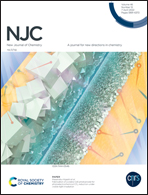Structural characterization and luminescence properties of trigonal Cu(i) iodine/bromine complexes comprising cation–π interactions†
Abstract
Three-coordinate mononuclear copper(I) halide complexes (1 (I) and 2 (Br)) that bear a novel rigid diphosphine ligand derived from a benzimidazole skeleton were prepared and characterized. Structural analyses of 1 and 2 reveal that the rigidity of the functionalized diphosphine ligand leads to weak Cu⋯πimidazole interactions. Solid state luminescence studies show that the existence of cation–π interactions and the heavy atom effect facilitate orange-red emission (630 nm for 1 and 615 nm for 2) with high photoluminescence quantum yields (65% and 72% for 1 and 2, respectively) and decay times of a few tenths of microseconds. The combination of experimental results and quantum-chemical calculations reasonably reveals that the emission origin is assigned to TADF-assisted phosphorescence based on (metal + halide) to ligand transitions. This systematic study demonstrates that the introduction of a functional π-conjugated bridging moiety between the two P atoms in the diphosphine ligands is a promising strategy for developing new structures with high luminescence performance.



 Please wait while we load your content...
Please wait while we load your content...